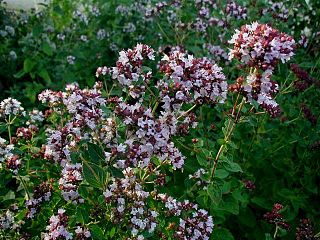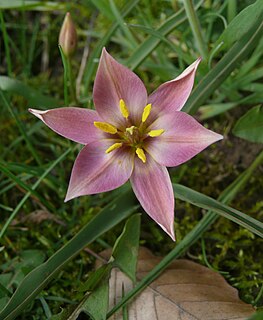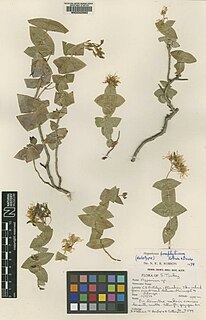
Ajuga, also known as bugleweed, ground pine, carpet bugle, or just bugle, is a genus of 40 species annual and perennial herbaceous flowering plants in the Ajugeae tribe of the mint family Lamiaceae, with most species native to Europe, Asia, and Africa, but also two species in southeastern Australia. They grow to 5–50 cm tall, with opposite leaves.

Origanum is a genus of herbaceous perennials and subshrubs in the family Lamiaceae, native to Europe, North Africa, and much of temperate Asia, where they are found in open or mountainous habitats. A few species also naturalized in scattered locations in North America and other regions.

Lilium martagon, the martagon lily or Turk's cap lily, is a Eurasian species of lily. It has a widespread native region extending from Portugal east through Europe and Asia as far east as Mongolia.

Aethionema is a genus of flowering plants within the family Brassicaceae. They are known as stonecresses. Stonecresses originate from sunny limestone mountainsides in Europe and West Asia, especially Turkey.

Heinrich Gustav Adolf Engler was a German botanist. He is notable for his work on plant taxonomy and phytogeography, such as Die natürlichen Pflanzenfamilien, edited with Karl A. E. von Prantl.

The Rafflesiaceae are a family of rare parasitic plants comprising 36 species in 3 genera found in the tropical forests of east and southeast Asia, including Rafflesia arnoldii, which has the largest flowers of all plants. The plants are endoparasites of vines in the genus Tetrastigma (Vitaceae) and lack stems, leaves, roots, and any photosynthetic tissue. They rely entirely on their host plants for both water and nutrients, and only then emerge as flowers from the roots or lower stems of the host plants.

Astronium is a genus of flowering plants in the cashew family, Anacardiaceae. It is native to Central and South America.

Hymenocrater is a genus of plants from the mint family. It is native to central and southwestern Asia from Turkey to Turkmenistan and Pakistan.
- Hymenocrater adenothrixRech.f. - Afghanistan
- Hymenocrater altimuranusRech.f. - Afghanistan
- Hymenocrater bituminosusFisch. & C.A.Mey. - Turkey, Iran, Caucasus
- Hymenocrater calycinus(Boiss.) Benth. - Turkmenistan, Iran
- Hymenocrater elegansBunge - Turkmenistan, Iran
- Hymenocrater incanusBunge - Iran
- Hymenocrater inciaidentatusBoriss. - Turkmenistan
- Hymenocrater longiflorusBenth. - Iran, Iraq
- Hymenocrater oxyodontusRech.f. - Iran
- Hymenocrater platystegiusRech.f. - Iran
- Hymenocrater sessilifoliusBenth. - Afghanistan, Iran, Pakistan
- Hymenocrater yazdianusRech.f. - Iran

Tapinanthus is a genus of mistletoe in the family Loranthaceae, endemic to Africa. The name of the genus is derived from the Greek tapeinos meaning "low" or "humble" and anthos meaning flower.

Iris × germanica is the accepted name for a species of flowering plants in the family Iridaceae commonly known as the bearded iris or the German bearded iris. It is one of a group of hybrid origin. Varieties include I. × g. var. florentina.

Tulipa humilis is a species of flowering plant in the lily family, found in Syria, Lebanon, Israel, Turkey, Iran, and the North Caucasus region of Russia. The flowers are pink with yellow centers. Its preferred habitat are rocky mountain slopes. It is known by several other names in horticulture.
Ian Charleson Hedge was a Scottish botanist at the Royal Botanic Gardens in Edinburgh. Hedge made important contributions to the flora of Iran and Iraq, and was a recognised authority on the flora of south-west Asia. He named more than 300 new plant species.

Lysionotus is a genus of flowering plants in the family Gesneriaceae. It occurs in the Himalayas, China, Japan, and Southeast Asia. The genus was described by David Don in 1822.
Campanula lazica is a species of flowering plant in the bellflower family, Campanulaceae. It is endemic to northeast Anatolia, Turkey.

Hypericum pallens, commonly known as the Pale St. John's wort or Mount Lebanon St. John's wort, is a species of flowering plant in the family Hypericaceae which is found in Turkey, Lebanon, and Syria.

Hypericum pamphylicum is a species of flowering plant in the family Hypericaceae which is endemic to Turkey.
Hypericum minutum is a flowering plant in the genus Hypericum, sect. Adenosepalum.
Glaucosciadium is a genus of flowering plants belonging to the family Apiaceae.
Helichrysum artvinense, the Artvinian everlasting, is a herbaceous plant, a member of the family Asteraceae.

Nigella arvensis, the field nigella or wild fennel flower, is a species of flowering plant in the family Ranunculaceae. It is native to North Africa, central, southern and eastern Europe, the Caucasus region, and the Middle East as far as Iran, and has gone extinct in Switzerland and Crete. It is a minor crop, used locally as a substitute for Nigella sativa, black caraway.















